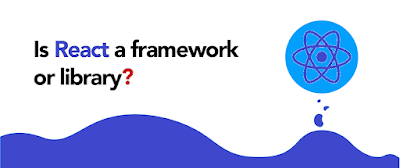React is often referred to as a JavaScript library because it is primarily a library focused on building user interfaces. While React can be used to build entire web applications, it specifically targets the view layer of the application. React doesn't provide features for handling routing, managing global state, or making HTTP requests on its own, which are common functionalities required in a complete web application. Instead, React focuses on efficiently rendering UI components and updating the UI in response to changes in data or state.
Here are a few reasons why React is called a JavaScript library:
1. View Layer: React's core purpose is to handle the view layer of the application. It provides developers with a way to create reusable UI components and efficiently update the UI based on changes in data. React doesn't dictate how the rest of the application should be structured or interact with other parts of the application.
2. Composable Components: React promotes a component-based architecture, where UIs are broken down into smaller, reusable components. These components can be composed and combined to create more complex UIs. React's focus on components makes it behave like a library, as developers can choose to use React's components within their applications.
3. Lightweight and Focused: React is designed to be lightweight and focused on the specific task of handling the UI. It doesn't come with additional features and functionalities that might be found in a full-fledged framework. This modularity makes it more flexible and allows developers to combine React with other libraries or frameworks as needed.
4. Integration Flexibility: Since React is a library and not a full framework, developers have more flexibility in integrating it into existing projects or combining it with other libraries or frameworks. It's common to see React used alongside other libraries like Redux for state management, React Router for routing, and Axios for handling HTTP requests.
5. Ecosystem and Community: As a JavaScript library, React benefits from a large and active community of developers who create and share additional tools, extensions, and libraries that enhance the React ecosystem. This has led to the development of various companion libraries and tools that work well with React.
React is often referred to as a "JavaScript library for building user interfaces" because its primary focus is on creating and managing the user interface of web applications. It is not a complete framework like Angular or Vue.js, which offer more comprehensive solutions for building entire applications, including routing, state management, and more.
Here are some reasons why React is classified as a JavaScript library:
1. User Interface (UI) Focus: React is designed specifically to handle the view layer of an application, providing a way to build dynamic, interactive, and reusable user interfaces efficiently. It excels at rendering and updating UI components based on changes in data or state, thanks to its virtual DOM and component-based architecture.
2. Lightweight: Compared to full-fledged frameworks, React is lightweight. It allows developers to use it alongside other libraries or frameworks as needed, giving them more flexibility in choosing other parts of their stack.
3. Declarative Approach: React follows a declarative programming paradigm, where developers describe what the UI should look like based on the current state, and React takes care of updating the actual DOM to match that state. This makes the code more intuitive and easier to maintain.
4. Component-Based: React is built around the concept of reusable components. Components are modular, self-contained units that can be composed together to create complex UIs. This design promotes code reusability and organization.
5. DOM Abstraction: React abstracts the underlying DOM manipulation through its virtual DOM implementation. This means developers can work with a virtual representation of the DOM, which is more performant and allows React to optimize updates efficiently.
6. Open Source and Extensible: React is open-source, and its core library can be extended with additional functionality through third-party libraries and packages. Developers can choose and use additional tools as needed to build the rest of their application stack.
7. Focused Community Development: The React community is primarily dedicated to enhancing UI-related functionality. For more complex needs like routing and state management, developers can integrate React with other libraries, enabling a flexible and customized approach.




0 Comments